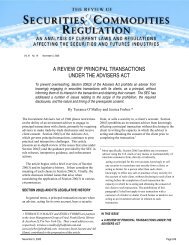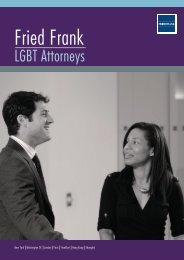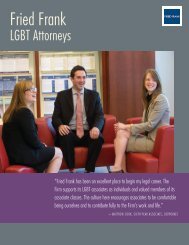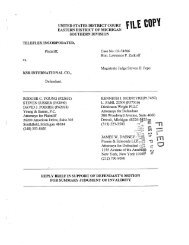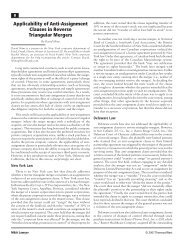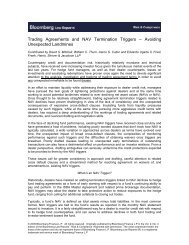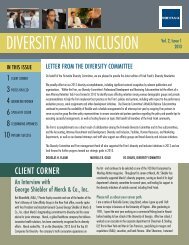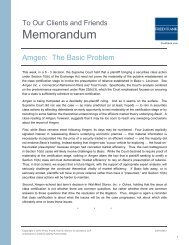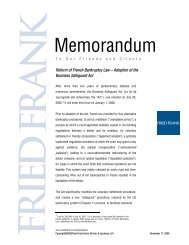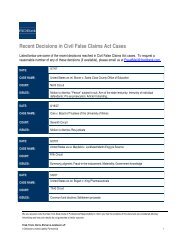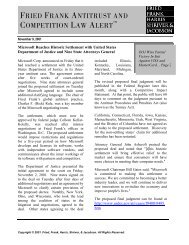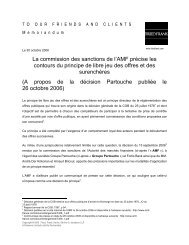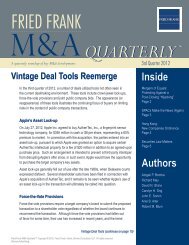CIVIL FALSE CLAIMS ACT: Eighth Circuit Rejects ... - Fried Frank
CIVIL FALSE CLAIMS ACT: Eighth Circuit Rejects ... - Fried Frank
CIVIL FALSE CLAIMS ACT: Eighth Circuit Rejects ... - Fried Frank
You also want an ePaper? Increase the reach of your titles
YUMPU automatically turns print PDFs into web optimized ePapers that Google loves.
The Rule requires any fraud claim to specify “the time, place, and content of the<br />
defendant’s false representations, as well as the details of the defendant’s fraudulent<br />
acts, including when the acts occurred, who engaged in them, and what was obtained as<br />
a result.”<br />
[ . . . . ]<br />
But as this Court [has] . . . made clear, while the requirements of Rule 9(b) must be read<br />
in harmony with the principles of notice pleading, a fraud claim still “must identify who,<br />
what, where, when, and how.”<br />
[ . . . . ]<br />
A qui tam complaint that fails to meet Rule 9(b)’s specificity requirements is a “legally<br />
invalid complaint” that “cannot form the basis for recovery” under the FCA.<br />
Gov’t Reply Br. at 17-19.<br />
The <strong>Eighth</strong> <strong>Circuit</strong> panel reaffirmed the importance of Rule 9(b) and its role as a safeguard that protects<br />
defendants from frivolous accusations and provides notice of the claims against them. But the court<br />
rejected the government’s theory that Rule 9(b), which is “meant to test the sufficiency of a complaint at<br />
its outset,” has any bearing on a relator’s share determination under § 3730(d)(1) at the end of the case<br />
when there is no longer any opportunity to cure a deficiency. 1<br />
The Court therefore affirmed the district court’s determination that Relators were entitled to both a 21<br />
percent recovery on the $9 million kickback claim (which was not in dispute on appeal) and also a 15<br />
percent recovery on the $46 million recovery on the Contract 35F defective pricing claim. The end result<br />
is that DOJ had to pay out to the Relators $7 million more than it anticipated when it settled the matter<br />
with HP.<br />
Also, as a practical matter, the <strong>Eighth</strong> <strong>Circuit</strong>’s ruling underscores the importance of resolving relator’s<br />
share and attorneys’ fee issues at settlement in intervened cases. In particular, if attorneys’ fees liability<br />
is not resolved at settlement, particularly where there is an unresolved dispute between the relator and<br />
the government over the relator’s share payment, the defendant may end up being responsible for<br />
additional attorneys’ fees liability. It should be noted that attorneys’ fees liability also can be created in<br />
other settings where a qui tam action has been filed, including cases where the government has resolved<br />
the matter through an alternate remedy or contract modifications. See, e.g., United States ex rel. Barajas<br />
v. Northrop Corp., 258 F.3d 1004 (9th Cir. 2001) (ruling that, under the circumstances of the case,<br />
suspension and debarment proceeding was an alternate remedy); United States ex rel. Alderson v.<br />
1<br />
The court also examined cases cited by the government and found that they did nothing to advance the<br />
government’s argument. 2013 WL 764734, at *9-10. Specifically, the court distinguished the Sixth <strong>Circuit</strong>’s<br />
decision in United States ex rel. Bledsoe v. Community Health Systems, 501 F.3d 493 (6th Cir. 2007) (“Bledsoe<br />
II”) as an “alternate remedy” case in which the government began its investigation before the relator filed the qui<br />
tam suit, it did not intervene in the qui tam action, and the relator failed to establish a connection between his<br />
action and the government’s existing settlement. Also, the court determined that the Supreme Court’s decision<br />
in Rockwell International Corp. v. United States, 549 U.S. 457 (2007) did not apply because relator’s action in<br />
that case was challenged as based on publicly disclosed allegations and the Supreme Court ruled that the relator<br />
was not an “original source,” but the government in Roberts did not challenge Relators’ claim under the “direct<br />
and independent” standard of the original source provision.<br />
<strong>Fried</strong> <strong>Frank</strong> FraudMail Alert ® No. 13-03-08 03/08/2013<br />
4



